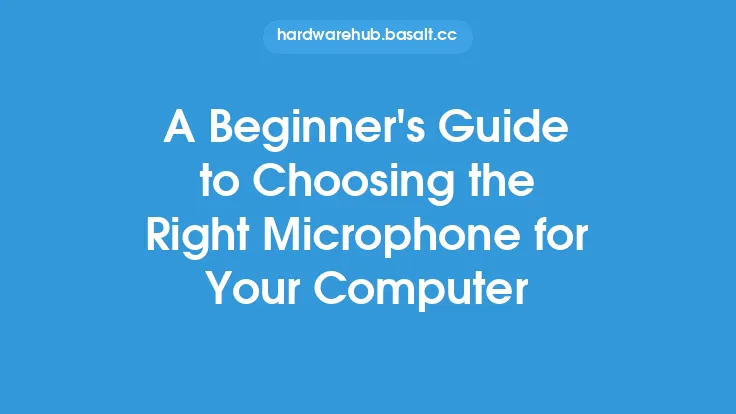Reducing background noise and echo when using a microphone is crucial for achieving high-quality audio, whether you're recording music, podcasts, voiceovers, or streaming. Background noise can be distracting and detract from the overall listening experience, while echo can make your audio sound unprofessional and amateurish. In this article, we'll explore the causes of background noise and echo, and provide you with practical tips and techniques for minimizing them.
Understanding Background Noise
Background noise refers to any unwanted sound that is present in the environment where you're recording or streaming. This can include sounds like traffic, air conditioning, computer fans, or even the hum of a refrigerator. Background noise can be particularly problematic when using condenser microphones, which are designed to pick up a wide range of frequencies and are often more sensitive to ambient noise. To reduce background noise, it's essential to identify the sources of the noise and take steps to eliminate or minimize them. This can include turning off fans and appliances, using noise-reducing materials like acoustic panels or soundproofing blankets, or even recording in a different location.
Understanding Echo
Echo, on the other hand, refers to the reflection of sound waves off surfaces in the recording environment. When sound waves bounce off walls, ceilings, or floors, they can create a repeating pattern of sound that can be heard as an echo. Echo can be particularly problematic in rooms with hard surfaces, like wood or tile floors, and can be exacerbated by the use of microphones with a wide pickup pattern. To reduce echo, it's essential to use techniques like sound absorption and diffusion, which can help to break up sound waves and prevent them from reflecting off surfaces.
Acoustic Treatment
One of the most effective ways to reduce background noise and echo is to use acoustic treatment in your recording environment. Acoustic treatment refers to the use of materials and techniques to control the way sound waves behave in a room. This can include the use of acoustic panels, which are designed to absorb sound waves and prevent them from reflecting off surfaces. Acoustic panels can be made from a variety of materials, including fiberglass, mineral wool, or open-cell foam, and can be placed strategically around the room to maximize their effectiveness. Other acoustic treatment techniques include the use of soundproofing blankets, which can be used to cover walls and ceilings, and the use of diffusers, which can help to break up sound waves and prevent them from reflecting off surfaces.
Microphone Placement
The placement of your microphone can also play a significant role in reducing background noise and echo. When placing your microphone, it's essential to consider the proximity effect, which refers to the way sound waves behave when they're close to a surface. When a microphone is placed close to a surface, it can pick up more bass frequencies, which can help to reduce background noise. However, if the microphone is placed too close to a surface, it can also pick up more echo and reverberation. To minimize background noise and echo, it's often best to place the microphone at a distance of around 6-8 inches from the sound source, and to use a microphone with a narrow pickup pattern, like a cardioid or supercardioid pattern.
Microphone Selection
The type of microphone you use can also play a significant role in reducing background noise and echo. Dynamic microphones, for example, are often less sensitive to background noise and echo than condenser microphones, and are a good choice for recording in noisy environments. Ribbon microphones, on the other hand, are often more sensitive to background noise and echo, but can provide a warm and detailed sound that's well-suited to certain types of music and voiceovers. When selecting a microphone, it's essential to consider the specific needs of your project, and to choose a microphone that's well-suited to the task at hand.
Signal Processing
Finally, signal processing techniques can also be used to reduce background noise and echo. These techniques can include the use of noise reduction software, which can help to identify and remove background noise from your audio. Other signal processing techniques, like equalization and compression, can also be used to help minimize background noise and echo, and to create a more polished and professional sound. When using signal processing techniques, it's essential to use them judiciously, as over-processing can lead to a sound that's unnatural and lacking in character.
Conclusion
Reducing background noise and echo when using a microphone requires a combination of technical knowledge, practical techniques, and attention to detail. By understanding the causes of background noise and echo, and by using techniques like acoustic treatment, microphone placement, and signal processing, you can help to minimize these problems and achieve high-quality audio that's free from distractions and imperfections. Whether you're recording music, podcasts, voiceovers, or streaming, the tips and techniques outlined in this article can help you to create a more professional and polished sound that will engage and inspire your listeners.





